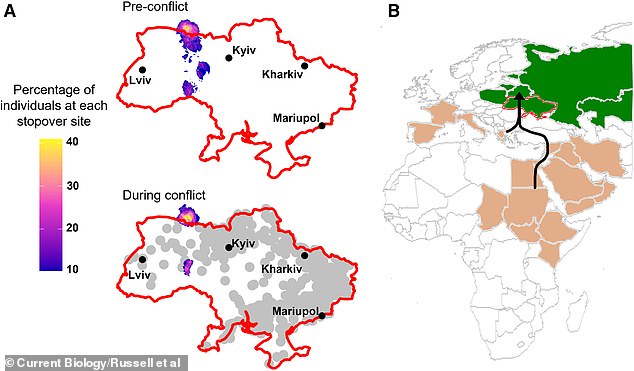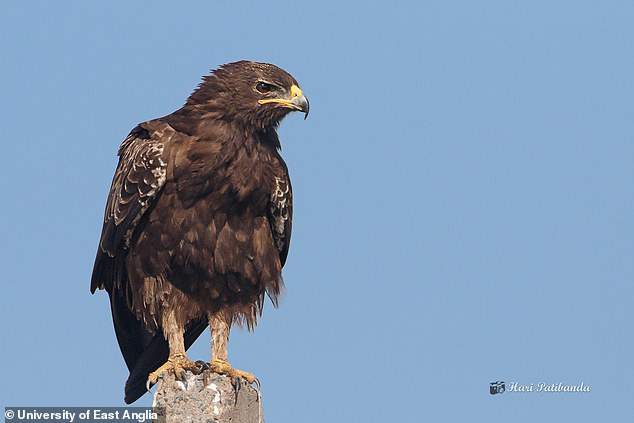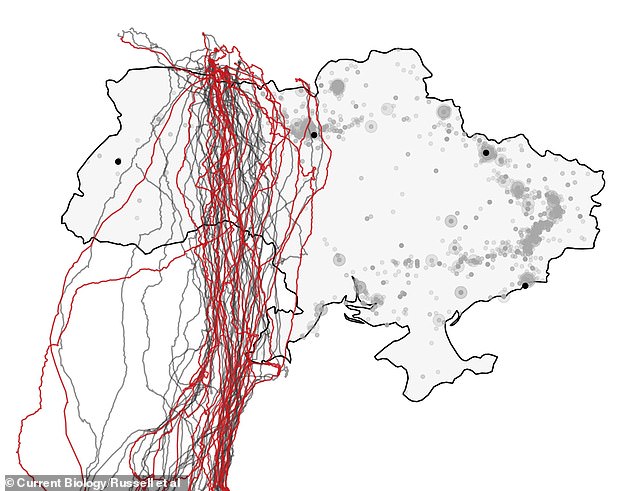How the war in Ukraine has impacted migrating eagles: Birds have been forced to deviate from their usual flight plan to avoid active conflict zones, study reveals
- Before the war, birds migrated from Southern Europe and East Africa, Belarus
- After February 2022, they were forced to make major deviations from their routes
Every spring, thousands of Great Spotted Eagles make the arduous journey from East Africa and Greece to southern Belarus to breed.
Now, for the first time, a study has revealed the impact of the war in Ukraine on this annual migration.
Researchers from the University of East Anglia found that shortly after Ukraine was invaded by Russia, the birds’ usual migration route was changed.
“The war in Ukraine has had a devastating impact on people and the environment,” said Charlie Russell, lead author of the study.
‘Our findings provide a rare insight into how conflict affects nature, improving our understanding of the potential consequences of exposure to such events or other extreme human activities that are difficult to predict or monitor.’
Every spring, thousands of Great Spotted Eagles make the arduous journey from East Africa and Greece to southern Belarus to breed

Researchers from the University of East Anglia found that shortly after Ukraine was invaded by Russia, the birds’ usual migration route was changed
In the study, the researchers wanted to understand whether the Great Spotted Eagle’s migration was affected by the Russian invasion of Ukraine.
The team was already studying the species and had fitted the eagles with GPS tracking equipment.
This allowed them to compare movement and migration before and shortly after the Russian invasion in February 2022.
An analysis of the GPS data revealed how the birds followed a migration path from southern Europe (females) and eastern Africa (males) to an important breeding site in southern Belarus before the conflict.
However, after February 2022, the birds were forced to make major deviations from their traditional routes, traveling an average of 85 additional kilometers.
This meant that their migrations took longer.

In the study, the researchers wanted to understand whether the Great Spotted Eagle’s migration was affected by the Russian invasion of Ukraine.

The team was already studying the species and had fitted the eagles with GPS tracking equipment. This allowed them to compare movement and migration before and shortly after the Russian invasion in February 2022
Female migrations took 246 hours compared to 193 hours before the conflict, while men took 181 hours to complete the journey compared to 125 hours before the conflict.
Fewer birds stopped in Ukraine at all, with only 30 percent of birds surveyed making a stopover, compared to 90 percent in 2018-2021.
Some important stopover points, such as Ukrainian Poland, were not used at all in 2022.
“These types of disturbances can have significant effects on the behavior and possibly fitness of the eagles,” Russell warned.
‘For individuals breeding in these areas, or for other species that are less able to respond to disturbance, the consequences are likely to be much greater.’
Worryingly, the researchers warn that this change in migration route could have lasting consequences for Great Spotted Sea Eagles.
Dr. Adham Ashton-Butt, a Senior Research Ecologist at the British Trust for Ornithology, added: ‘Migratory birds such as Greater Spotted Eagles are declining dramatically around the world and it is imperative that we better understand and mitigate our impacts on these charismatic species . ‘
